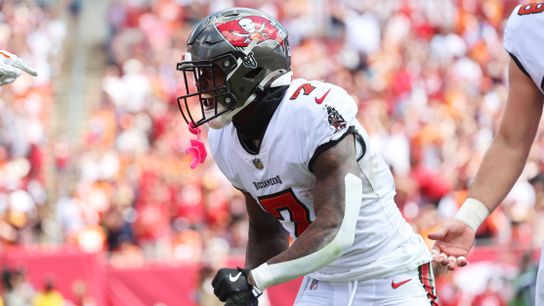To say that last week did not go as planned for the Tampa Bay Buccaneers would be a dramatic understatement.
Coming off of an emotional victory in Detroit to start the year 2-0, expectations were high for Tampa Bay; they were a near-touchdown favorite at home against a winless Denver Broncos team. Nevertheless, the Buccaneers were ambushed to the tune of a 26-7 defeat and now face a daunting schedule ahead.
In times like this, it can be difficult to find the shining light. Fortunately, Bucky Irving is here to provide it.
Over the past two seasons, no team has rushed for fewer yards per game or per attempt than the Buccaneers. Consequently, they made it a priority to address their rushing attack this offseason, drafting center Graham Barton in the first round of the 2024 NFL Draft, signing interior offensive lineman Ben Bredeson, and hiring new offensive coordinator Liam Coen to implement a diverse zone-rushing attack. Not to be forgotten, though, was the selection of Irving in the fourth round, immediately providing the team with a complementary option to incumbent starter Rachaad White that the team did not have last year.
So far, Irving has done more than deliver. The Buccaneers still rank in the bottom 10 in the NFL in total rushing production and efficiency, yet Irving’s 6.2 yards per attempt trails only Lamar Jackson and Saquon Barkley among all players. To boot, he ranks in the top eight in both yards before contact per attempt (3.5, T-4th) and yards after contact per attempt (2.7, T-8th), and leads Tampa Bay in every notable rushing category despite getting only 36.2% of the team’s overall carries. Suffice it to say, it’s been an impressive start for the rookie, and it’s only going to lead to more opportunities moving forward.
Head coach Todd Bowles went on record this week saying that Irving has earned more carries, a reasonable reaction after Irving logged 70 yards on nine carries in Sunday’s loss, including an impressive 32-yard run that generated 29 extra yards over expectation, per NFL Next Gen Stats. For perspective, those rushing yards over expectation are tied for the 14th-largest total this season on an individual carry this season, and showcased precisely what makes him a special talent.
Irving is a tenacious downhill runner who doesn’t waste any time finding his rushing lane and accelerating. This style of rushing allows him to compensate for unproductive carries with enough explosive runs (he ranks just 30th of 51 qualifiers in rushing success rate yet third in efficiency), which is significantly important for a Buccaneers rushing attack that has not been able to find consistency for multiple years. If you can’t sustain rushing production through consistent gains, having the ability to make that up with a 30-yard run is a great tool to unlock. They lacked this weapon previously, but Irving changed the picture notably.
Naturally, with White averaging just 2.1 yards per attempt, there has been a noticeable cry for Irving to become the team’s starting running back. However, while Irving continues to showcase his skill set and earns more opportunities, that doesn’t discount what White brings to the table. Not only did he total 272 carries last year, but the third-year pro also logged 64 catches for 549 yards through the air and is a player the team trusts tremendously. While Bowles did say Irving has earned more carries, he was also quick to dismiss the notion that the team’s rushing struggles elsewhere fell exclusively on White:
"At the same time, we're going to need Bucky and Rachaad all year. Bucky has some scheme runs that worked and Rachaad had some that didn't. That doesn't mean he is playing better — that means we couldn't get the [holes] open when we had Rachaad back there.”
It’s important to note that White’s percentage of carries when facing at least eight defenders in the box is more than twice that of Irving’s, as is the percentage of his carries when the team is tasked with six or fewer yards to gain for a first down. In simple terms, he’s being relied upon more in situations where it is not as conducive to gain large chunks of yardage on the ground. Moreover, two of Irving’s three longest runs of the season have come on beautifully designed plays with both him and White working together in a pony formation, including both of his longest runs against Denver. White has continued to demonstrate tremendous ability to perform after the catch (11.9 yards after catch/reception, 3rd in NFL) and is a dynamic player in space. He also remains the team’s trusted option in pass protection situations, according to Rick Stroud of the Tampa Bay Times, something often overlooked yet tremendously important regarding running back contributions.
Ultimately, the Buccaneers, in spite of the loss to Denver, are moving in a generally positive direction regarding their main offseason focus. White’s opportunities for larger gains should come over time as holes open up, especially with right tackle Luke Goedeke likely to return to the starting lineup this week. Meanwhile, Irving provides them with the explosiveness they’ve been missing for multiple years and complements White tremendously. Regardless of what’s to come, the future is certainly bright for the rookie.
The best part about sports? Even in the midst of defeat, there is always a shining light to move things forward.



